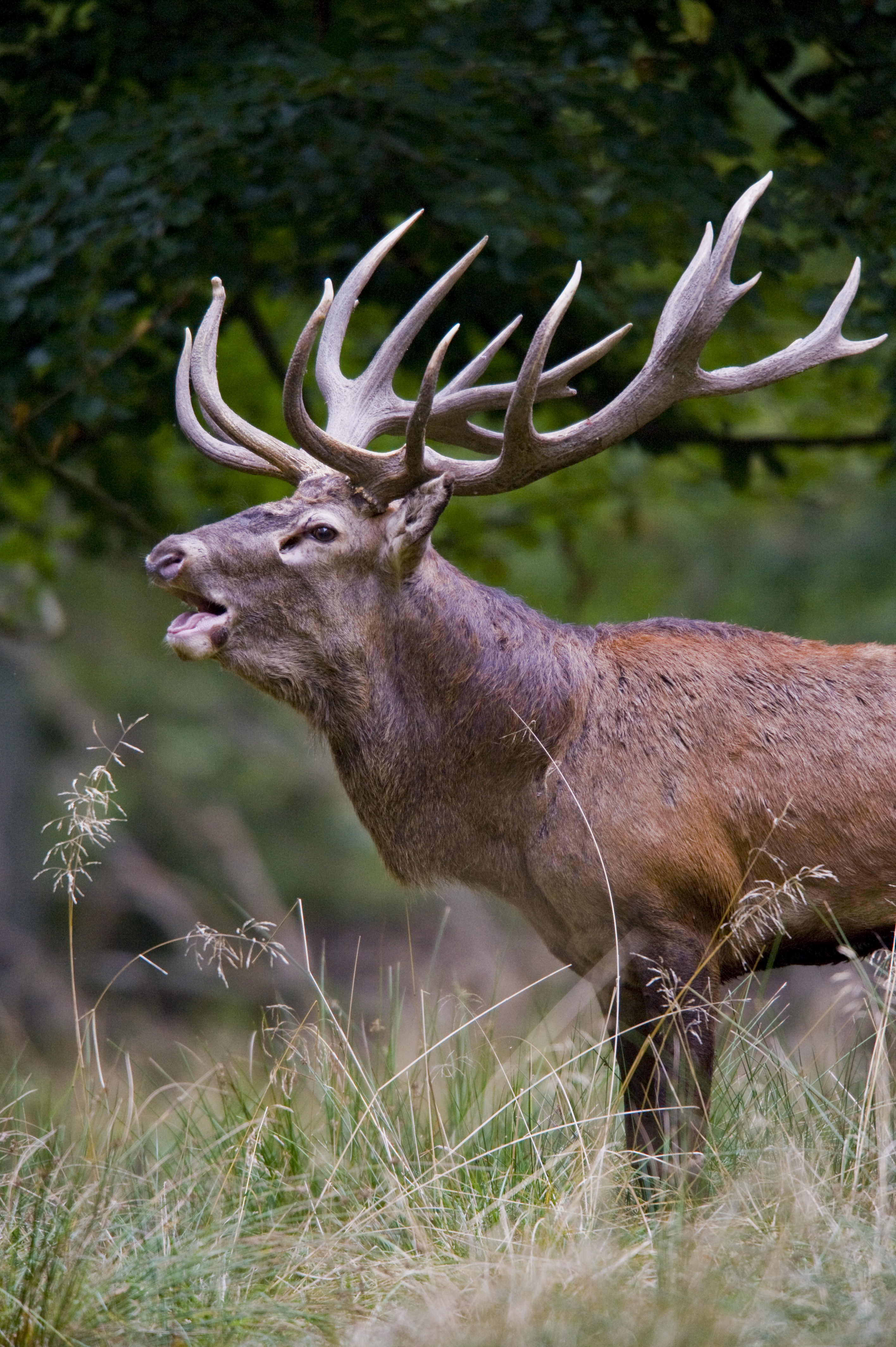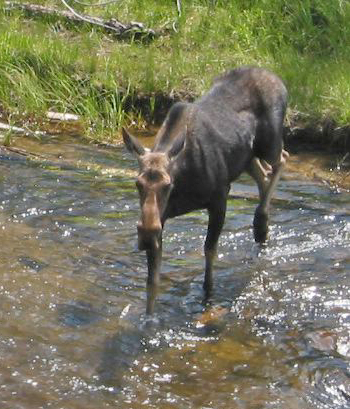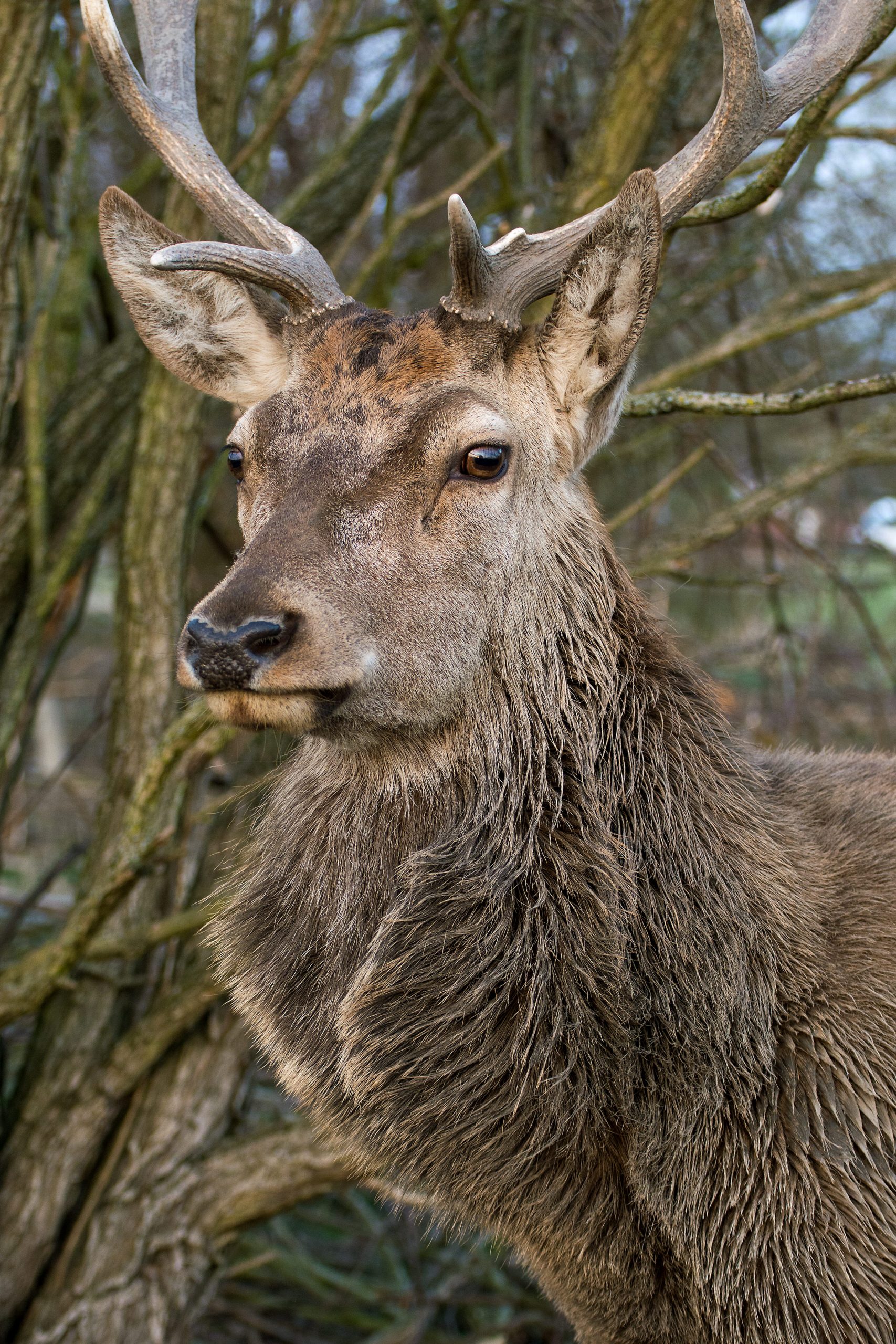|
Cervid
A deer (: deer) or true deer is a hoofed ruminant ungulate of the family Cervidae (informally the deer family). Cervidae is divided into subfamilies Cervinae (which includes, among others, muntjac, elk (wapiti), red deer, and fallow deer) and Capreolinae (which includes, among others reindeer (caribou), white-tailed deer, roe deer, and moose). Male deer of almost all species (except the water deer), as well as female reindeer, grow and shed new antlers each year. These antlers are bony extensions of the skull and are often used for combat between males. The musk deer ( Moschidae) of Asia and chevrotains (Tragulidae) of tropical African and Asian forests are separate families that are also in the ruminant clade Ruminantia; they are not especially closely related to Cervidae. Deer appear in art from Paleolithic cave paintings onwards, and they have played a role in mythology, religion, and literature throughout history, as well as in heraldry, such as red deer that appear ... [...More Info...] [...Related Items...] OR: [Wikipedia] [Google] [Baidu] |
Antler
Antlers are extensions of an animal's skull found in members of the Cervidae (deer) Family (biology), family. Antlers are a single structure composed of bone, cartilage, fibrous tissue, skin, nerves, and blood vessels. They are generally found only on males, with the exception of Reindeer, reindeer/caribou. Antlers are Moulting, shed and regrown each year and function primarily as objects of sexual attraction and as Weapon (biology), weapons. Etymology Antler comes from the Old French ''antoillier ''(see present French : "Andouiller", from'' ant-, ''meaning before,'' oeil, ''meaning eye and'' -ier'', a suffix indicating an action or state of being) possibly from some form of an unattested Latin word ''*anteocularis'', "before the eye" (and applied to the word for "branch" or "horn (anatomy), horn"). Structure and development Antlers are unique to cervids. The ancestors of deer had tusks (long upper canine tooth, canine teeth). In most species, antlers appear to replace t ... [...More Info...] [...Related Items...] OR: [Wikipedia] [Google] [Baidu] |
Ruminantia
Ruminants are herbivorous grazing or browsing artiodactyls belonging to the suborder Ruminantia that are able to acquire nutrients from plant-based food by Enteric fermentation, fermenting it in a specialized stomach prior to digestion, principally through microbial actions. The process, which takes place in the front part of the digestive system and therefore is called foregut fermentation, typically requires the fermented ingesta (known as cud) to be regurgitated and chewed again. The process of rechewing the cud to further break down plant matter and stimulate digestion is called rumination. The word "ruminant" comes from the Latin ''ruminare'', which means "to chew over again". The roughly 200 species of ruminants include both domestic and wild species. Ruminating mammals include cattle, all domesticated and wild bovines, goats, sheep, giraffes, deer, gazelles, and antelopes.Fowler, M.E. (2010).Medicine and Surgery of Camelids, Ames, Iowa: Wiley-Blackwell. Chapter 1 General B ... [...More Info...] [...Related Items...] OR: [Wikipedia] [Google] [Baidu] |
Water Deer
The water deer (''Hydropotes inermis'') is a small deer species native to Korea and China. Its prominent tusks, similar to those of musk deer, have led to both subspecies being colloquially named vampire deer in English-speaking areas to which they have been imported. It was first described to the Western world by Robert Swinhoe in 1870. Taxonomy There are two subspecies: the Chinese water deer (''H. i. inermis'') and the Korean water deer (''H. i. argyropus''). The water deer is superficially more similar to a musk deer than a true deer; despite anatomical peculiarities, including a pair of prominent tusks (downward-pointing canine teeth) and its lack of antlers, it is classified as a cervid. Yet its unique anatomical characteristics have caused it to be classified in its own genus (''Hydropotes'') as well as historically its own subfamily (Hydropotinae). However, studies of mitochondrial control region and cytochrome b DNA sequences placed it near '' Capreolus'' within an ... [...More Info...] [...Related Items...] OR: [Wikipedia] [Google] [Baidu] |
Reindeer
The reindeer or caribou (''Rangifer tarandus'') is a species of deer with circumpolar distribution, native to Arctic, subarctic, tundra, taiga, boreal, and mountainous regions of Northern Europe, Siberia, and North America. It is the only representative of the genus ''Rangifer''. More recent studies suggest the splitting of reindeer and caribou into six distinct species over their range. Reindeer occur in both Animal migration, migratory and wiktionary:sedentary#Adjective, sedentary populations, and their herd sizes vary greatly in different regions. The tundra subspecies are adapted for extreme cold, and some are adapted for long-distance migration. Reindeer vary greatly in size and color from the smallest, the Svalbard reindeer (''R.'' (''t.'') ''platyrhynchus''), to the largest, Osborn's caribou (''R. t. osborni''). Although reindeer are quite numerous, some species and subspecies are in decline and considered Vulnerable species, vulnerable. They are unique among deer (Ce ... [...More Info...] [...Related Items...] OR: [Wikipedia] [Google] [Baidu] |
Ruminant
Ruminants are herbivorous grazing or browsing artiodactyls belonging to the suborder Ruminantia that are able to acquire nutrients from plant-based food by fermenting it in a specialized stomach prior to digestion, principally through microbial actions. The process, which takes place in the front part of the digestive system and therefore is called foregut fermentation, typically requires the fermented ingesta (known as cud) to be regurgitated and chewed again. The process of rechewing the cud to further break down plant matter and stimulate digestion is called rumination. The word "ruminant" comes from the Latin ''ruminare'', which means "to chew over again". The roughly 200 species of ruminants include both domestic and wild species. Ruminating mammals include cattle, all domesticated and wild bovines, goats, sheep, giraffes, deer, gazelles, and antelopes.Fowler, M.E. (2010).Medicine and Surgery of Camelids, Ames, Iowa: Wiley-Blackwell. Chapter 1 General Biology and ... [...More Info...] [...Related Items...] OR: [Wikipedia] [Google] [Baidu] |
Caribou
The reindeer or caribou (''Rangifer tarandus'') is a species of deer with circumpolar distribution, native to Arctic, subarctic, tundra, boreal, and mountainous regions of Northern Europe, Siberia, and North America. It is the only representative of the genus ''Rangifer''. More recent studies suggest the splitting of reindeer and caribou into six distinct species over their range. Reindeer occur in both migratory and sedentary populations, and their herd sizes vary greatly in different regions. The tundra subspecies are adapted for extreme cold, and some are adapted for long-distance migration. Reindeer vary greatly in size and color from the smallest, the Svalbard reindeer (''R.'' (''t.'') ''platyrhynchus''), to the largest, Osborn's caribou (''R. t. osborni''). Although reindeer are quite numerous, some species and subspecies are in decline and considered vulnerable. They are unique among deer (Cervidae) in that females may have antlers, although the prevalence of an ... [...More Info...] [...Related Items...] OR: [Wikipedia] [Google] [Baidu] |
Moschidae
Moschidae is a family of pecoran even-toed ungulates, containing the musk deer (''Moschus'') and its extinct relatives. They are characterized by long "saber teeth" instead of horns, antlers or ossicones, modest size (''Moschus'' only reaches ; other taxa were even smaller) and a lack of facial glands. While various Oligocene and Miocene pecorans were previously assigned to this family, recent studies find that most should be assigned to their own clades, although further research would need to confirm these traits. As a result, '' Micromeryx'', '' Hispanomeryx'', and ''Moschus'' are the only undisputed moschid members, making them known from at least 18 Ma. The group was abundant across Eurasia and North America during the Miocene, but afterwards declined to only the extant genus ''Moschus'' by the early Pleistocene. Taxonomy and classification Until the early 21st century, it was believed that the musk deer (family Moschidae) were an adjacent, sister-group to the "true deer" ... [...More Info...] [...Related Items...] OR: [Wikipedia] [Google] [Baidu] |
Cervinae
The Cervinae or the Old World deer, are a subfamily of deer. Alternatively, they are known as the plesiometacarpal deer, due to having lost the parts of the second and fifth metacarpal bones closest to the foot (though retaining the parts away from the foot), distinct from the telemetacarpal deer of the Capreolinae (which have instead retained these parts of those metacarpals, while losing the parts away from the foot instead). Classification and species The following species are recognised in extant genera:Alvarez D. (2007) * Tribe Muntiacini ** Genus '' Elaphodus'' *** Tufted deer (''E. cephalophus'') ** Genus '' Muntiacus'' *** Bornean yellow muntjac (''M. atherodes'') *** Hairy-fronted muntjac (''M. crinifrons'') *** Fea's muntjac (''M. feae'') *** Gongshan muntjac (''M. gongshanensis'') *** Indian muntjac (''M. muntjak'') *** Sumatran muntjac (''M. montanum'') *** Pu Hoat muntjac (''M. puhoatensis'') *** Leaf muntjac (''M. putaoensis'') *** Reeves's muntjac (''M. re ... [...More Info...] [...Related Items...] OR: [Wikipedia] [Google] [Baidu] |
Moose
The moose (: 'moose'; used in North America) or elk (: 'elk' or 'elks'; used in Eurasia) (''Alces alces'') is the world's tallest, largest and heaviest extant species of deer and the only species in the genus ''Alces''. It is also the tallest, and the second-largest, land animal in North America, falling short only to the American bison in body mass. Most adult male moose have broad, palmate ("open-hand shaped") antlers; other members of the deer family have pointed antlers with a dendritic ("twig-like") configuration. Moose inhabit the circumpolar boreal forests or temperate broadleaf and mixed forests of the Northern Hemisphere, thriving in cooler, temperate areas as well as subarctic climates. Hunting shaped the relationship between moose and humans, both in Eurasia and North America. Prior to the colonial era (around 1600–1700 CE), moose were one of many valuable sources of sustenance for certain tribal groups and First Nations. Hunting and habitat loss hav ... [...More Info...] [...Related Items...] OR: [Wikipedia] [Google] [Baidu] |
Venison
Venison refers primarily to the meat of deer (or antelope in South Africa). Venison can be used to refer to any part of the animal, so long as it is edible, including the internal organs. Venison, much like beef or pork, is categorized into specific primal cut, cuts, including roasting, roast, sirloin steak, sirloin, and ribs (food), ribs. Etymology The word derives from the Latin , meaning . This term entered the English language through Norman French in the 11th century, following the Norman Conquest of England and the establishment of Royal Forests. Definition ''Venison'' originally described any meat obtained through the process of hunting a wild game animal. It was applied to any animal from the family (biology), families Cervidae (true deer), Leporidae (rabbits and hares), Suidae (wild boar) and certain species of the genus ''Capra (genus), Capra'' (goats and ibex). In Southern Africa, the word ''venison'' refers to the meat of antelope, a Bovidae taxon, as there are n ... [...More Info...] [...Related Items...] OR: [Wikipedia] [Google] [Baidu] |
Cervus
''Cervus'' is a genus of deer that primarily are native to Eurasia, although one species occurs in northern Africa and another in North America. In addition to the species presently placed in this genus, it has included a whole range of other species now commonly placed in other genera. Additionally, the species-level taxonomy is in a state of flux. Taxonomy Genus Until the 1970s, ''Cervus'' also included the members of the genera '' Axis'', '' Dama'', and '' Elaphurus'', and until the late 1980s, it included members of '' Rucervus'' and '' Rusa''. Species In the third edition of ''Mammal Species of the World'' from 2005, only the red deer (''C. elaphus'') and sika deer (''C. nippon'') were recognized as species in the genus ''Cervus''. Genetic and morphological evidence suggest more species should be recognized. For example, the species '' Cervus canadensis'' (elk/wapiti) is considered a separate species. Red deer species group Within the red deer species group, some sour ... [...More Info...] [...Related Items...] OR: [Wikipedia] [Google] [Baidu] |
Capreolinae
The Capreolinae, Odocoileinae, or the New World deer are a subfamily of deer. Alternatively, they are known as the telemetacarpal deer, due to their bone structure being different from the plesiometacarpal deer subfamily Cervinae. The telemetacarpal deer maintain their distal lateral metacarpals, while the plesiometacarpal deer maintain only their proximal lateral metacarpals. The Capreolinae are believed to have originated in the Middle Miocene, between 7.7 and 11.5 million years ago, in Central Asia. Although this subfamily is called New World deer in English, it includes reindeer, moose, and roe deer, all of which live in Eurasia in the Old World. Classification The following extant genera and species are recognized:Alvarez D. (2007) * Tribe Capreolini ** Genus '' Capreolus'' *** Western roe deer (''C. capreolus'') *** Eastern roe deer (''C. pygargus'') **Genus '' Hydropotes'' *** Water deer (''H. inermis'') * Tribe Alceini **Genus ''Alces'' *** Moose or Eurasian elk (' ... [...More Info...] [...Related Items...] OR: [Wikipedia] [Google] [Baidu] |









